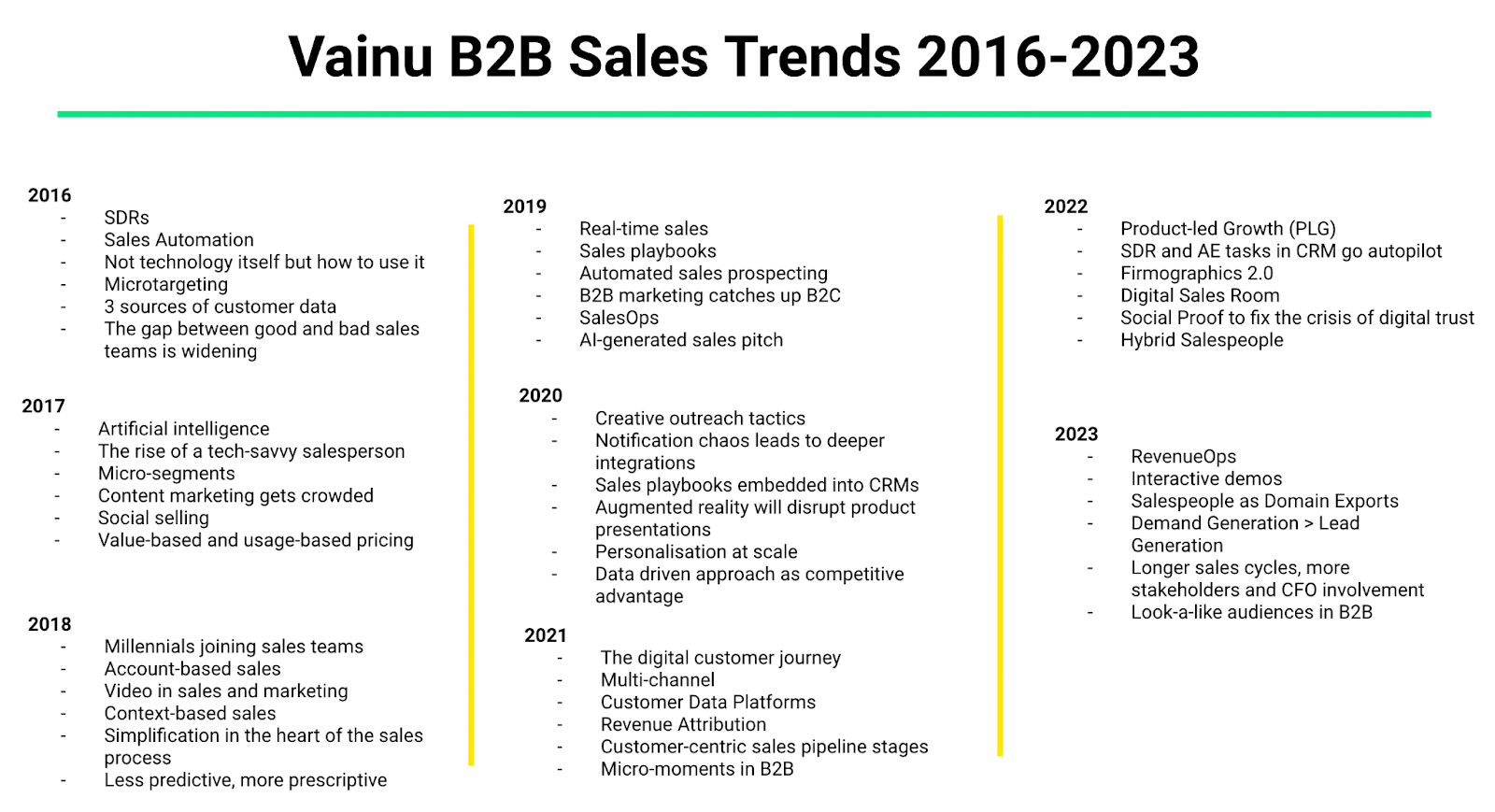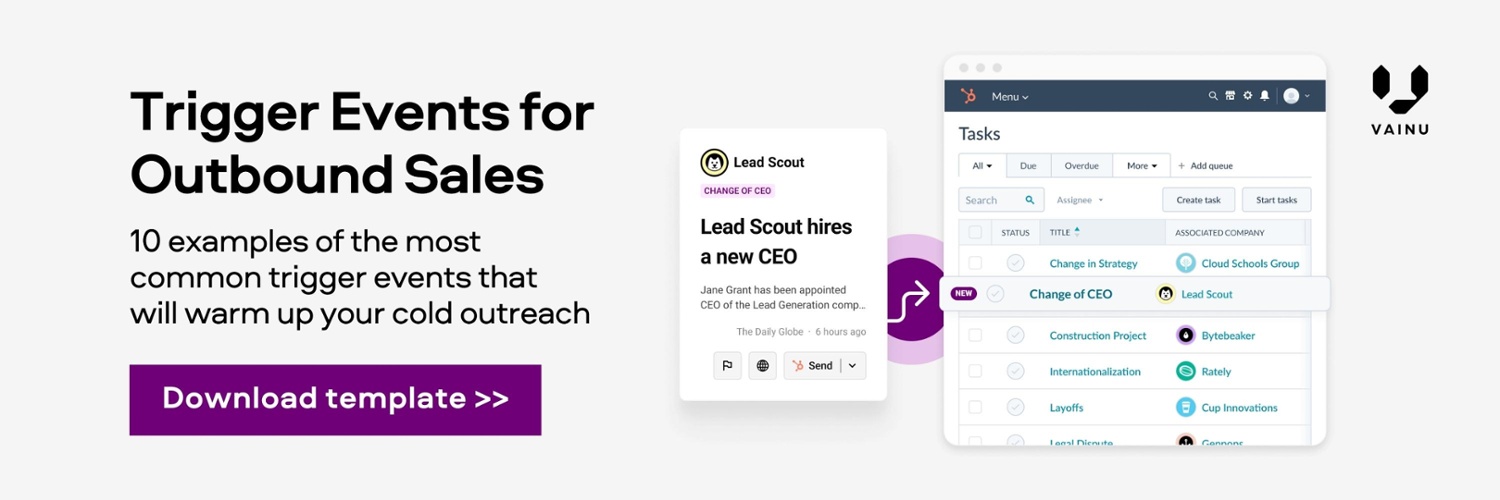B2B Sales Trends 2024
It’s been an interesting year in B2B sales, to say the least. In this more challenging macroeconomic environment, we’ve witnessed longer sales cycles and more stakeholders being involved not just in the larger deals but also those with relatively small deal values. Many Account Executives have missed their quota, and many sales teams have experienced layoffs and increased pressure to deliver.
At the same time, there’s been a lot of excitement (or worry, depending on who you ask) and confusion about the rapid technological developments, especially in the field of artificial intelligence.
Yet there is one thing you can rely on in these turbulent times: Our forecast of the trends that will shape the B2B sales landscape in the coming year. This has been a tradition here at Vainu for almost the entire duration of the company’s existence, with this year marking our nine-year anniversary.
If you’re curious about what predictions we’ve made in the past, below you can see our predictions from 2016 to 2023 👇

Let’s now dust off our predictive radar and see what trends (we believe) will be the most important for B2B sales in 2024!
B2B Sales Trends 2024
1. The increased use of Generative AI in sales
Today, many sales teams use AI assistants, such as ChatGPT, to create and finetune their sales emails and other collaterals needed throughout the sales process.
2023 can be seen as a year when the adoption of GenAI started with curious individuals, but in 2024, RevOps teams will be ready for more systematic and company-wide implementations. We think the use cases won’t be limited to content creation but also encompass other parts of the job, such as prospecting, forecasting, and sales coaching.
It’s interesting to note that in our first predictions for 2016 & 2017, we expected sales automation and artificial intelligence to gain momentum in B2B sales. AI-generated sales pitch was mentioned for the first time in our 2019 trend report. Clearly, we were a little ahead of the curve with those predictions!
2. The transition to signal/trigger-based outbound
Five years ago, one of our trends was “real-time sales.” With this concept, we emphasized the importance of using all available signals (or triggers, as we call them) when deciding which customers to contact and when to reach out to them.
Most likely, many of you have heard that Google and Yahoo are implementing new rules in 2024 for “bulk senders”—those who send more than 5,000 messages daily. Obviously, these new rules, email authentication, one-click unsubscribing, and a low spam complaint rate will have an impact on cold outreach tactics.
Therefore, we believe that sales teams can no longer rely on a “spray and pray” methodology and instead need to become smarter and more data-driven in how they go about building their pipelines. Fortunately, the technology needed to run “personalization at scale” campaigns has already been available for several years.
Typically, the signals necessary to create “personalization at scale” campaigns can be divided into behavioral signals, third-party intent data, and sales trigger events. Leveraging these signals enables salespeople to reach out to prospects at precisely the right moment while being compliant with the data regulations and policies.
3. The beginning of the "nearbound" methodology
Compared to outbound and inbound, “nearbound” is the new kid on the block, so there's no shame in not recognizing this jargon. Basically, it refers to going after accounts that already live in your “ecosystem,” i.e., the companies that are the customers or prospects of your partners, with the aim being to drive revenue together with your partners through data sharing, co-marketing, and co-selling.
To facilitate this methodology, a growing number of platforms (Reveal, Crossbeam, etc.) allow companies to securely share customer data so that partners can identify shared opportunities and collaborate closely during the sales process.
In our 2022 predictions, we highlighted Product-Led Growth; this year, we predict there’ll be more people talking about Partner/Ecosystem-Led growth where joint opportunities can unlock new avenues for growth. This approach is likely valuable for companies that rely heavily on integrations like many SaaS sectors do.
4. The return of self-generated pipeline for AEs
In 2016, the prevalence of Sales Development Representatives (SDRs) increasing was our first trend prediction. While we continue to believe that SDRs will play an important role in pipeline generation, this year, we predict that sales leaders will take a step back and highlight the importance of Account Executives building (at least some) pipeline themselves.
Now, when new technology has made it almost too easy to reach out to hundreds of decision-makers daily, many buyers are ignoring cold emails and LinkedIn messages because their inboxes are simply getting too crowded. Hence, SDRs are having a hard time.
And it’s in this situation that experience, references, and shared connections—things that AEs generally have more of than SDRS—become an incredibly valuable tool. Therefore, AEs (and company executives!) are well-positioned to drive pipeline growth but need to carve out time for these activities.
5. The telephone making a comeback
Using multiple channels throughout the sales process is important, as noted in our 2021 predictions. Successful salespeople know when to write an email, when to engage in social media, and when to push for F2F meetings. It’s not only about understanding which medium is the most effective but also about figuring out the one that is the least crowded.
Could the good old phone make a notable comeback in 2024? It might very well do so. And not only for the first initial contact but also for all the moments of engagement throughout the sales process.
With the emphasis on LinkedIn InMails, emails, and discussions in Slack/Teams shared channels, there are a lot of salespeople who are very used to only written communications. Sales leaders might, therefore, benefit from coaching phone work. For quick checkups and reminders, the phone is still the most real-time technology a salesperson can hope for.
6. The end of search(?)
People who prospect are very familiar with search filters. Just like we all do when we’re searching for apartments, hotels, trips, or other products, salespeople apply search filters when looking for ideal prospects that meet their ICP criteria.
But, in the world of consumer business, you don’t always need to search to find what you’re looking for, with several platforms providing recommendations, such as Amazon, Netflix, and many others. We think that the same should be possible also in B2B sales.
If you find one customer that’s a really good fit, there shouldn’t be a need to apply filters to find similar businesses; you should just be able to request that your prospecting tool or CRM show you lookalike companies.
And if you use a large group of companies—such as your best-performing customer segment—you can nowadays ask a computer to cluster them into segments and then request lookalikes per each segment. At least, you can do that with Vainu.
This eliminates the need for search filters. These AI-driven algorithms can identify similar companies with precision and have the potential to become real game-changers in B2B sales productivity.
See you next year!
In wrapping up, the B2B sales landscape for the coming year seems both exciting and challenging at the same time. The integration of GenAI, signal-based outreach, and nearbound strategies reflects an industry adapting to the latest technology.
The renewed focus on phone communications and the move towards self-generated sales pipelines for AEs emphasize the importance of diverse, proactive, multi-channel approaches.
Additionally, the declining reliance on manual search filters indicates a future where AI-driven precision streamlines prospecting for all salespeople.
Of course, only time will reveal whether these predictions come true, but we’re eagerly waiting to see how these trends will shape the evolving B2B sales landscape in the upcoming year.

